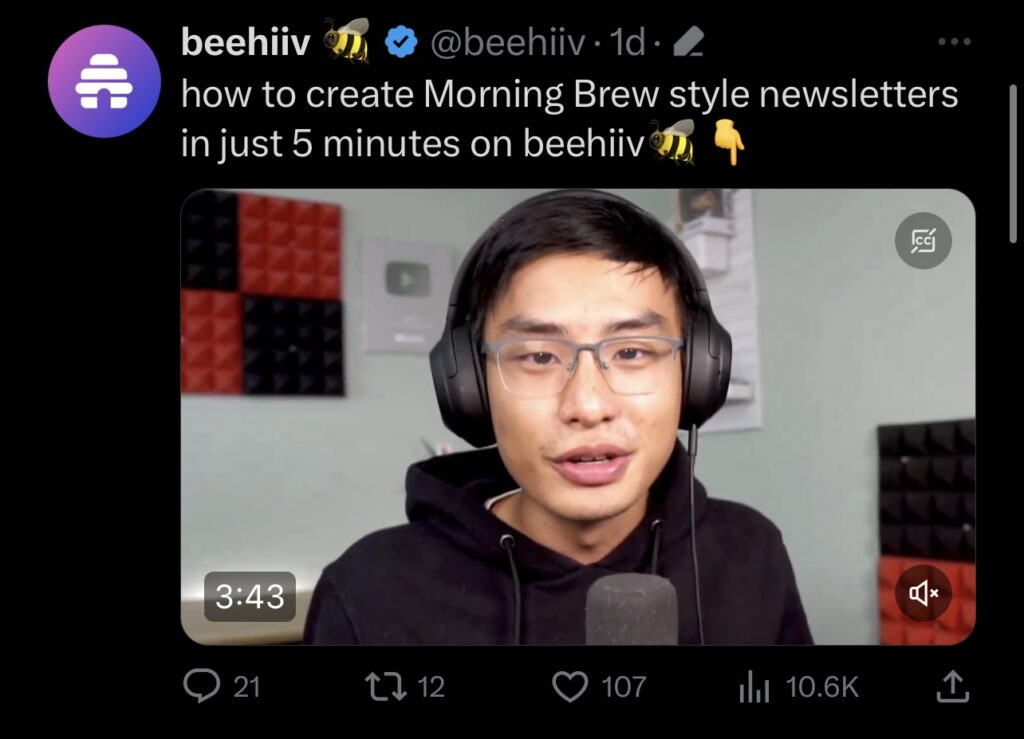21 September 2023 | Marketing
Social Strategy 101: Using copy to support video creative
By
Beehiiv—and newsletter platform for creators and businesses—is executing their social content strategy as well as any software company I’ve seen.
I’ll do a full deep dive into their strategy at some point (perhaps this coming Monday), but today I want to get super tactical and focus on one particular post.
This is a prime example of how to use copy + video to hook people who are scrolling the timeline. This example is on Twitter/X, but you can apply this to any platform.
First, the post. I’d recommend clicking through here so you can actually watch the video.
By the numbers:
- 10.1K views
- 105 likes
- 102 bookmarks (super strong like: bookmark ratio)

Ok, ready for some tactics?
Cool.
Takeaway 1: Lean into video on Twitter/X more than you used to.
It’s our job as social media professionals to stay up to date on what’s working on platforms. In my work for clients at my agency, I’m seeing video perform quite well. The sentiment isn’t unique to me though. I’ve been seeing other marketers and creators echo this.
Writing isn’t ‘dead,’ but video is in. Beehiiv has made video a core part of their social strategy. This is a great example. It’s clear that effort and editing was put into this piece of creative. It earns the scroller’s attention, and isn’t just a haphazard podcast clip pulled together
Takeaway 2: When paired together, the role of the social copy is to draw attention to the creative asset.
The media should do most of the talking. The copy’s role is simply to aid in stopping the scroll, and getting a relevant user interested enough to watch the video. Nothing else.
Let’s look at the copy in this post:
“how to create Morning Brew style newsletters in just 5 minutes on beehiiv 🐝👇”
One line. Simple. Clean.
More copy is not always better. Sometimes—most of the time—cutting the fluff is better for social copy than writing more words for the sake of it.
As long as it moves the viewer to the video.
Caveat: I have seen use cases in having the copy rephrase exactly what the video says, as a way to add value to those with sound off or those that just prefer to read over watch. Generally though, using the copy to drive attention to the creative asset is a good approach.
Takeaway 2: Borrow credibility from bigger names your ICP recognizes.
Compare these 2 alternatives:
- how to create aesthetically appealing newsletters in just 5 minutes on beehiiv
- how to create Morning Brew style newsletters in just 5 minutes on beehiiv
Both pieces of copy are ‘good.’ But I’d bet money that the second variant outperforms the first when tested side-by-side.
Why?
Morning Brew is one of the most widely known newsletters in the world. On Twitter, newsletter creators view them as aspirational. They have clout. And using ‘Morning Brew’ in the copy borrows that clout.
The reader will think, “I want to make newsletters like Morning Brew. I should watch this!”
Name-jacking, or whatever you want to call it, is such an easy lever to pull to increase distribution on your social content as a startup (though Beehiiv is anything but ‘small’ at this point).
I use this all the point. Hell, I’m doing it right now talking about Beehiiv as an example. When I repurpose this newsletter to Twitter, it will probably rip, for that reason.
And for these 2 reasons, this post is going in my Swipe File.
By the way, if you want to grab my exact Swipe File template I use to keep track of inspiration and never run out of content ideas, check it out here.
